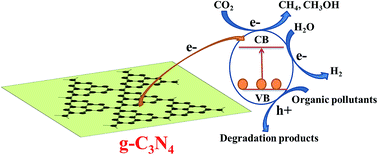A mini-review on the synthesis and structural modification of g-C3N4-based materials, and their applications in solar energy conversion and environmental remediation
Abstract
In recent years, graphitic carbon nitride (g-C3N4) has shown promising performance as a metal-free conjugated polymer containing graphitic stacking of C3N4 layers, which are constructed from tri-s-triazine units connected by planar amino groups. Pure g-C3N4 with a band gap energy of 2.7 eV (460 nm) makes it an applicable and efficient visible-active photocatalyst for energy conversion and environmental applications. This is because of its appropriate electronic band structures, efficient optical absorption, and extraordinary thermal and chemical stability. Currently, the major focus in photocatalysis research is on the design and development of visible-light-driven photocatalysts that are stable and highly efficient for practical applications. In this current mini-review, a comprehensive survey is conducted on graphitic carbon nitride (g-C3N4) as a metal-free novel visible-light photocatalyst and the progress in the synthesis and design of high-efficiency g-C3N4-based nanomaterial photocatalysts with controllable structures and morphologies is discussed in detail. Various approaches for modifying the electronic band structure and visible-light harvesting, including metal (cation), non-metal (anion) doping, noble metal loading, and composite formation with other semiconductors are discussed in detail. Photocatalytic applications of g-C3N4 as metal-free catalysts in photocatalytic water splitting for hydrogen production, CO2 photoreduction, organic pollutant degradation, and bacterial disinfections are introduced and discussed in detail. Finally, this critical mini-review summarizes some outlooks on the ongoing challenges in the development of efficient and low cost metal-free g-C3N4 systems, which provide a good complement to the literature on g-C3N4 based metal-free nanomaterial photocatalysts.



 Please wait while we load your content...
Please wait while we load your content...